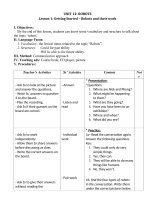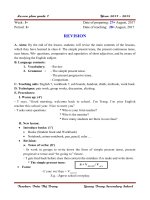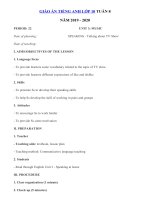Tieng Anh 8 Sach moi Giao an hoc ki 1
Bạn đang xem bản rút gọn của tài liệu. Xem và tải ngay bản đầy đủ của tài liệu tại đây (169.39 KB, 48 trang )
Week:
Date of planning: /
/
Period: 44
Date of teaching: / /
UNIT 6: FOLK TALES
LESSON 1: GETTING STARE- A SUGGESTION FOR NICK’S
PROJECT
I. Objectives:
1. Knowledge: By the end of the lesson, students should
be able to:
- Use an exclamatory sentence with the correct intonation.
- Use the lexical items related to the topic “ Folk tales”.
- Use the past continuous tense correctly.
- Distinguish between the past continuous tense and the simple
past tense.
2. Skills
- By the end of the unit, Ss will be able to:
Speaking
- Talk about a legend/ folk tale/ fairy tale/ fable( its plot, main
character….).
Listening
- Listen to get specific information I a fairy tale.
Reading
- Read for specific information in a fairy tale.
Writing
- Write a narrative of a legend/ folk tale/ fairy tale/ fable.
3. Attitude: Learn passively and enthusiastically
II- Teaching aids
- CD player, poster..
III. Procedure
A. Class organization.
- Greeting.
- Checking attendance:
B. New lesson.
Teacher’s
activities
. Warm up:
Game
Ss work in two
big groups A
and B. Each
student calls
out the name of
a Vietnamese
festival, then
points at one
student from
group B. This
student has to
call out the
name of
another
Vietnamese
festival. The
game stops
when a group
cannot give the
name of any
Vietnamese
festival of when
time is up. The
Students’
Contents
activities
work in two
big groups
Ss play game
A and B.
Each
student
calls out
the name
of a
Vietnames
e festival.
Competen
ce
Playing
game to
review last
lesson
1. Listen
&read:
Vocabulary:
Research (n)
Legend(n)
Fable(n)
Listening
and reading
group with more
names of
Vietnamese
fedtival wins.
Origin(n)
Activities Ask
Ss questions
about the
picture:
Where are
Duong and
Nick?
a) Read the
conversation
again and
chose the
correct
answers :
Origin(n)
Produce(v)
Key:
What are
they doing?
2. C
What are
they talking
about??
- Elicit some
new words
* Checking
vocab: Rub-out
and remember.
1: Play the
recording. Ss
listen and read.
a. have Ss work
independently.
Then ask them
to share
answers before
discussing as a
class.
- T corrects and
gives the
1. B
C
Answer the
questions
3. A
5. A
4.
b) Match the
words to their
meaning
Key:
1. c
2.d
listen and
read
work
independe
ntly.
3.a
4.b
c.Find the
information in
the
conversation
to complete
sentences
Title: Lac Long
Quan, Au Co
Genre: Legend
work in
pairs to
Main characters:
Lac Long Quan,
feedback.
match the
words to
their
b Have Ss work meanings
in pairs to
match the
words to their
to share
meanings. Then answers
ask them to
before
share answers
discussing
before
as a class
discussing as a
class
c Again, ask Ss
not to look at
the book and
try to remember
the information
about the
legend of Lac
Long Quan and
Au Co, and
complete the
table. Then ask
Ss to open their
discuss the
books and
question in
check their
pairs
answers.
Au Co, and their
sons
The plot:
- Lac
Long
Quan married
Au Co.
- Au Co gave
birth to one
hundred baby
boys.
- Lac
Long
Quan missed
the sea.
- Lac
Long
Quan
took
fifty of their
sons to the
sea.
- Au Co took
the others to the
mountains
d. What does
this sentence
express?
( remember)
EX 1. What a
handsome
man( he is )!
2. What an
interesting
game ( it is
)!
3.
What
good news
( it is )!
d Have Ss
discuss the
question in
pairs. Then,
draw Ss’
attention to the
structure,
meaning and
use of
exclamatory
sentences by
analyzing the
instruction and
examples in the
Remember!
box. Write the
following on the
board:
4.
What
lovely dogs
(
they
are) !
Deducting
5.
What
brave
women
( they are )!
match the
types of
2. Match the
stories with
words with
their
their
definitions
definitions.the
n listen ,check
and repeat
Key: 1. C 2. D
3. B 4. A
2 Have Ss
quickly match
the types of
stories with
their definitions.
Then play the
work
recording for Ss
independe
to check their
ntly, filling
answers. Now
in the table
3. Game :
Guess the
story
( ss’ own
answers )
put Ss into pairs
to think of an
example of
each type of
story.
with the
information
of the
legend
-add a time limit
to increase the
fun. Ss raise
their hands
when they have
completed their
lists. Check
them with the
class
practice in
front of the
class
3 Game:
Guess the
story
a Have Ss
work
independently,
filling in the
table with the
information of
the legend, folk
tale, fable or
fairy tale they
know.
b First, model
this activity with
a more able
student. Then
ask Ss to work
in pairs. Call
some pairs to
practice in front
of the class.
3. Homework:
Prepare for A
closer look 1.
Learn the lesson
.
V. Comments
............................................................................................................
............................................................................................................
............................................................................................................
Week:
Date of planning: / /
Period: 45
/ /
Date of teaching:
UNIT 6: FOLK TALES
LESSON 2: A CLOSER LOOK 1
I. Objectives:
1. Knowledge: By the end of the lesson, students should
be able to:
- Use an exclamatory sentence with the correct intonation.
- Use the lexical items related to the topic “ Folk tales”.
- Use the past continuous tense correctly.
- Distinguish between the past continuous tense and the simple
past tense.
2. Skills
- By the end of the unit, Ss will be able to:
Speaking
- Talk about a legend/ folk tale/ fairy tale/ fable( its plot, main
character….).
Listening
- Listen to get specific information I a fairy tale.
Reading
- Read for specific information in a fairy tale.
Writing
- Write a narrative of a legend/ folk tale/ fairy tale/ fable.
3. Attitude: Learn passively and enthusiastically
II. Teaching aids:
- CD player, poster
III. Procedure
A. Class organization.
- Greeting.
- Checking attendance:
B. New lesson.
Teacher’s
activities
1. Warm
up:
- ask Ss to
share any
famous
Vietnames
e legends
they have
read:
Have you
ever read or
been told a
Students’
activities
share any
famous
Vietnames
e legends
Contents
Competenc
e
Communicati
ng
famous
Vietnamese
legend?
Vocabulary
Woodcutter (n)
What is its
title?
Knight(n)
What is it
about?
Hare(n)
Orge(n)
What are
the main
characters in
it?
Eagle(n)
Cunning( adj)
Brave(adj)
1. Matching
Key: 1. G
share their
answers
with one or
more
partners.
1.
First, have Ss
work
independently
. Then, ask
them to share
their answers work
with one or
independe
more
ntly.
partners. If
there is
enough time,
T can ask
2. C
3. E
4. B
5. H
6. A
7. D
8. F
2. These
creatures are
popular
characters in
fold tale .
Matching
Key: 1. G
2. F
3. A
4. E
5. B
6. C
7. H
8. D
3.The
Learning
vocab
them Ss to
write their
answers on
the board.
2. Have Ss
work
independently
. Ask them to
share their
answers with
one or more
partners.. If
time allows,
do the same
exercise with
the character work
independe
vocabulary
ntly then
share their
answers
with one or
more
partners
3.a.- Ss work
independently
then share
their answers
with one or
do the
more partners exercise in
- ask them Ss pairs
to write their
answers on
the board.
b Ask Ss to
do the
adjectives
a. Put them
into the correct
column
- positive
:cheerfull,
generous, brave,
kind
- negative :
cruel, mean , evil
, greedy ,
wicked, fierce,
cunning
b.
Example:
There’s wolf in
litlleredridinghoo
d . he’s cunning
and wicked
….
Pronunciation:
Intonation in
exclamatory
sentences
4. Listen and
repeat the
sentences. Pay
attention to
intonation.
-Note
:
Use
falling intonation
Pronunciatin
g
exercise in
pairs, using
the adjectives
in a to
describe
characters in
one of their
favourite folk
tales. Then
ask some Ss
to say their
sentences in
front of the
class.
4. T plays the
recording and
asks pupils to
listen and
repeat the
sentences,
paying
attention to
the intonation
of each
sentence..
- Remind Ss
that they use
falling
intonation for
exclamatory
sentences.
5.-Ask ss to
say their
sentences
in front of
the class.
listen and
repeat the
sentences
practice
saying the
sentences
first
- listen
and
repeat
for exclamatory
sentences.
Ex: what a
colourful hat she
is wearing
5. Practise
these
sentences then
listen and
repeat .
practice
saying the
sentences
first
- Call some
ss to
practice in
front of the
class
- Play the
recording,
ask ss to
listen and
repeat
3.
Homework:
Prepare for
next.
Learn by
heart some
words
V. Comments
............................................................................................................
............................................................................................................
............................................................................................................
Week:
Date of planning: / /
Period: 46
Date of teaching: / /
UNIT 6: FOLK TALES
LESSON 3: A CLOSER LOOK 2
I. Objectives:
1. Knowledge: By the end of the lesson, students should
be able to:
- Use an exclamatory sentence with the correct intonation.
- Use the lexical items related to the topic “ Folk tales”.
- Use the past continuous tense correctly.
- Distinguish between the past continuous tense and the simple
past tense.
2. Skills
- By the end of the unit, Ss will be able to:
Speaking
- Talk about a legend/ folk tale/ fairy tale/ fable( its plot, main
character….).
Listening
- Listen to get specific information I a fairy tale.
Reading
- Read for specific information in a fairy tale.
Writing
- Write a narrative of a legend/ folk tale/ fairy tale/ fable.
3. Attitude: Learn passively and enthusiastically
II. Teaching aids:
- poster
III. Procedure
A. Class organization.
- Greeting.
- Checking attendance:
B. New lesson.
Teacher’s
activities
Warm up:
Chatting with
Students’
activities
Contents
Competenc
e
Communicat
ing
Ss
Activities.
1a Ask Ss to
read part of the
conversation
from GETTING
STARTED,
paying
attention to the
underlined
part. Either
expain or elicit
from Ss the
form and use of
the past
continuous
tense.
Grammar:
read part
of the
conversati
on from
GETTING
STARTED
Past
continuous
tense
. 1a Ask Ss to
read part of
Listening
the
and writing
conversation
from GETTING
STARTED,
paying
attention to
the
underlined
part
Form :
(+) S +
was/were + Ving
b Before Ss
read the rules
and the
examples, you
can elicit any
rules from
them. Then ask
Ss to read the
read the
rules and
the
examples
(-) S +
was/were +not
+ V-ing
(?) Was/were+S
+ V-ing ?
Yes , S +
was/were
No, S +
Grammar box.
Draw Ss’
attention to the
use of the past
continuous
tense by
analyzing the
examples in
the Grammar
box. Then ask
some more
able Ss to give
some examples
2 Ask Ss to do
the grammar
exercise
individually.
Remind them
to look back at
the Grammar
box and use a
dictionary if
necessary.
Then have Ss
compare
answers in
pairs before
checking with
the whole
class.
3a Ask Ss to
do the
grammar
was/were +not
give some
examples
do the
grammar
exercise
individuall
y.
compare
answers in
pairs
do the
grammar
exercises
individuall
y
compare
answers in
b. Usage
- we use past
continuous to
describe an
action that was
in progress at a
started time in
the past
- we use past
continuous to
describe an
action that was
in progress
when another
shorter action
happen
2.Complete
the following
sentences by
putting the
verds in
bracket in
correct form .
Key:
1. was wearing
2.
were
you
doing
3. was doing
4. ran
5. was
Practicing
exercises
pairs
individually,
using the
suggested
words to write
sentences to
describe what
was happening
in each picture.
Remind them
to look back at
the grammar
box if
necessary.
Then have Ss
compare
work in
answers in
pairs.
pairs before
checking with
the whole
class.
b First, model
this activity
with a more
able student.
Then ask Ss to
work in pairs. T
may go around
to provide help.
not/wasn’t
waiting
3a. Using the
suggested
words to
write
sentences to
describe what
was
happening in
each picture
Key:
1. The
servant
was
spinning in
the woods.
2. The
girl
was
picking
flowers by
the side of
the road.
3. The
knights
were riding
(their
)
horses
to
the castle.
4. Cinderella
was
dancing
with
the
prince.
5. Saint Giong
was flying
to heaven.
6. The
orge
was
Call some pairs
to practice in
front of the
class.
roading
with anger.
b.Ask
and
answer the Qs
about
the
pictures
Key:
2. What was
the girl doing?
She was
picking flowers
by the side of
the road.
3. What were
the
knights
doing?
4 Ask Ss to do
the grammar
exercise
individually.
Remind them
to look back at
the Grammar
box and the
Look out! box.
Then have Ss
compare
answers in
pairs before
checking with
the whole
class.
do the
exercise
individuall
y.
They were
riding ( their )
horses to the
castle.
4. What was
the orge doing?
roaring
anger.
discuss
the
question
in pairs.
It was
with
5. What was
Saint
Giong
doing?
He was
fying to heaven.
4. Write
correct form
of each verd
5a T may do
the first
sentence as an
example for Ss
then have
them do the
exercise
individually.
Then have Ss
compare
answers in
pairs before
checking with
the whole
class.
b Have Ss
discuss the
question in
pairs. Then ask
Ss some pairs
to give their
answers to the
whole class. T
may give
comments or
invite
comments from
other Ss.
6a Ask Ss to
do the
grammar
exercises
individually,
Key:
do the
grammar
exercises
individuall
y,
1. was
walking,
stopped,
had
2. was lying,
heard,
needed
3. heard, was
following,
started
4. dropped,
ate
5. were
dancing,
left
was
missing/missed,
decided
5.Read the
fable and put
some
the verbs in
pairs to
demonstra to the past
te in front simple or past
continuos
of the
class.
Key:
1. was shining
2. was sleeping
3.
went
4. were fying
5. opened
6. fell
Practising
guessing what
their partner
was doing at
the times on
the clocks.
Remind them
to make a note
of their
guesses.
b - model this
activity with a
more able
student. Then
ask Ss to work
in pairs. T may
go around to
provide help.
Call some pairs
to demonstrate
in front of the
class.
3. Homework:
b. What is the
moralof the
fable
Suggested
answer: Be
happy/content
with what you
have
6a.Guessing
b. Ask your
partner to
check your
guess
Be ready for
Communication
Learn by heart
some words
and grammar.
V. Comments
............................................................................................................
............................................................................................................
............................................................................................................
Week:
Date of planning: / /
Period: 47
/ /
Date of teaching:
UNIT 6: FOLK TALES
LESSON 4: COMMUNICATION
I. Objectives:
1. Knowledge: By the end of the lesson, students should
be able to:
- Use an exclamatory sentence with the correct intonation.
- Use the lexical items related to the topic “ Folk tales”.
- Use the past continuous tense correctly.
- Distinguish between the past continuous tense and the simple
past tense.
2. Skills
- By the end of the unit, Ss will be able to:
Speaking
- Talk about a legend/ folk tale/ fairy tale/ fable( its plot, main
character….).
Listening
- Listen to get specific information I a fairy tale.
Reading
- Read for specific information in a fairy tale.
Writing
- Write a narrative of a legend/ folk tale/ fairy tale/ fable.
3. Attitude: Learn passively and enthusiastically
II. Teaching aids
- Sub-board
III. Procedure
A. Class organization.









